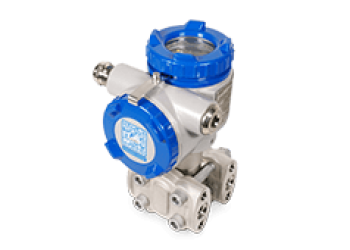
Differential pressure transmitter - FKC
ref : FKCFrom
1385,00 € Request a quoteThe pressure transmitter differential is a device that measures the pressure difference between two points in a system. This type of industrial pressure transmitter can measure very low differential pressures with great precision. An essential element of fluid mechanics, this differential pressure probe is used to regulate and control industrial processes, to measure tank levels and fluid flows, to detect gas or liquid leaks, to detect filter clogging and to monitor the performance of motors and pumps.

The pressure transmitter high-precision FKC differential models from pressure transmitter Fuji Electric measure differential pressure and transmit an electrical signal in the form of a 4-20 mA analog output.
Made in France, the differential transmitter uses a patented, reliable and resistant silicon capacitive chip, combined with advanced digital signal processing to deliver exceptional performance in terms of accuracy and stability.
This type of industrialpressure transmitter is highly accurate and can measure very low pressures with great precision.

Pressure transmitter differential with diaphragm seals

Differential diaphragm level sensor

Pressure transmitter for level or density measurement with diaphragm seal PFA
Differential pressure (dp) is the difference in pressure between two points.
The differential pressure cell compares two pressures measured between two points:
In this way, the differential pressure sensor converts the pressure difference (HP-BP) into a 4-20mA analog signal.


The differential pressure sensor has two pressure measurement ports: one for low pressure (BP or LP) and one for high pressure (HP).
Each port is connected to a metal membrane made of stainless steel or another material.
When the differential pressure of the industrial process is applied across each of these ports, it deforms the two membranes.
The pressure transmitter capacitive system measures pressure differences by deforming two metal diaphragms.
The metal diaphragms will transmit the measured differential pressure via an internal transmission fluid (oil) to the micro-capacitive electronic chip.
The differential pressure exerted on either side of this element will compress and deform the chip.
The deformation measured is proportional to the differential pressure to be measured.
The signal is then processed digitally by the electronics unit to convert the deformation into an analog 4-20 mA and digital HART signal.

The unit of measurement for differential pressure is the pascal (Pa).
Other commonly used differential pressure units include bar, millibar and mmCE.

A wide range of measurement ranges and pressure transmitters differential references are available. The selection of measurement ranges goes from 0 to 1 mbar for the lowest scales to 0 to 30 bar for the highest scales.
These differential pressure ranges meet the requirements of a wide range ofindustrial applications, ensuring effective monitoring of fluids (liquids, gases, steam) in your industrial processes.
Depending on the application, the 4-20 mA output signal can be programmed as either linear (output proportional to differential pressure) or square-root (output proportional to flow rate).
The square-root output function on a pressure transmitter differential can be used to measure fluid velocity.
The relationship between fluid velocity and the differential pressure generated by fluid flow(Bernoulli's law) is then used,

This relationship is expressed by the following equation:
V = sqrt((P1 - P2) / (1/2 * rho))
P1 = Pressure on the high pressure side -HP) measured upstream of the fluid flow
P2 = Pressure on the low pressure side (LP) measured downstream of the fluid flow
rho = Density of the fluid
V = Fluid velocity
The various types of pressure transmitters differential are used in a wide range of industrial applications. These include flow measurement, level measurement, filter clogging measurement and density measurement. Interface measurements are also part of their applications.
These differential pressure probes are widely used in many fields. These include thermal energy, thechemical industry, and theoil and gas industry.

Differential pressure sensors have many advantages for industrial processes.
ROBUST DESIGN
LOW DIFFERENTIAL PRESSURE
EXTREME TEMPERATURES
Measuring the pressure difference between two points in a system is simplified by the use of a differential pressure transmitter. This measuring instrument is designed to accurately measure the differential pressure and provide a corresponding digital pressure signal. With a differential pressure transmitter, you can accurately measure the pressure difference without the need for manual calculations.
Another way of measuring differential pressure is to use two transmitters from gauge pressure. You must then measure the pressure separately and manually calculate the pressure difference. This process can be laborious and error-prone.
In addition, if you are using two pressure transmitters relative transmitters, it is essential to ensure that each transmitter is accurately calibrated for precise pressure measurements. Indeed, if one of the pressure transmitters transmitters is out of phase, the differential pressure measurement may be incorrect.
The use of a pressure transmitter differential pressure gauge eliminates these problems and the risk of measurement errors. You use a single type of device, specifically designed for this application of differential pressure measurement. You get accurate, reliable measurement you can rely on. The commissioning stage of pressure transmitters is simplified by our user guides.